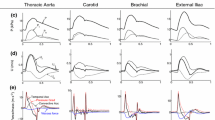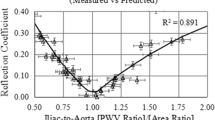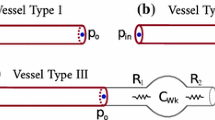Abstract
The mechanisms underlying the shape of pulse waves in the systemic arterial network are studied using the time-domain, one-dimensional (1-D) equations of blood flow in compliant vessels. The pulse waveform at an arbitrary location in the network is initially separated into a peripheral component that depends on the cardiac output, total compliance and total peripheral resistance of the network, and a conduit component governed by reflections at the junctions of the large conduit arteries and at the aortic valve. The dynamics of the conduit component are then analysed using a new algorithm that describes all the waves generated in the linear 1-D model network by a single wavefront starting at the root. This algorithm allows one to systematically follow all the waves arriving at the measuring site and identify all the reflection sites that these waves have visited. Application of this method to the pulse waves simulated using a 1-D model of the largest 55 systemic arteries in the human demonstrates that peripheral components make a larger contribution to aortic pressure waveforms than do the conduit components. Conduit components are closely related to the outflow from the left ventricle in early systole. Later in the cardiac cycle, they are the result of reflections at the arterial junctions and aortic valve. The number of reflected waves increases approximately as 3m, with m being the number of reflection sites encountered. The pressure changes associated with these waves can be positive or negative but their absolute values tend to decrease exponentially. As a result, wave activity is minimal during late diastole, when the peripheral components of pressure and the flow are dominant, and aortic pressures tend to a space-independent value determined by the cardiac output, total compliance and total peripheral resistance. The results also suggest that pulse-wave propagation is the mechanism by which the arterial system reaches the mean pressure dictated by the cardiac output and total resistance that is required to perfuse the microcirculation. The total compliance determines the rate at which this pressure is restored when the system has departed from its equilibrium state of steady oscillation. This study provides valuable information on identifying and measuring the parameters and pathways of the arterial network that have the largest effect on the simulated pulse waveforms.
Similar content being viewed by others
References
Olufsen MS, Peskin CS, Kim WY, Pedersen EM, Nadim A, Larsen J (2000) Numerical simulation and experimental validation of blood flow in arteries with structured-tree outflow conditions. Ann Biomed Eng 28: 1281–1299
Steele BN, Wan J, Ku JP, Hughes TJR, Taylor CA (2003) In vivo validation of a one-dimensional finite-element method for predicting blood flow in cardiovascular bypass grafts. IEEE Trans Biomed Eng 50: 649–656
Alastruey J (2006) Numerical modelling of pulse wave propagation in the cardiovascular system: development, validation and clinical applications. Ph.D. thesis, Imperial College London, University of London
Matthys KS, Alastruey J, Peiró J, Khir AW, Segers P, Verdonck PR, Parker KH, Sherwin SJ (2007) Pulse wave propagation in a model human arterial network: assessment of 1-D numerical simulations against in vitro measurements. J Biomech 40: 3476–3486
Hughes TJR, Lubliner J (1973) On the one-dimensional theory of blood flow in larger vessels. Math Biosci 18: 161–170
Pedley TJ (1980) The fluid mechanics of large blood vessels. Cambridge University Press, Cambridge, UK
Smith NP, Pullan AJ, Hunter PJ (2001) An anatomically based model of transient coronary blood flow in the heart. SIAM J Appl Math 62: 990–1018
Formaggia L, Lamponi D, Quarteroni A (2003) One-dimensional models for blood flow in arteries. J Eng Math 47: 251–276
Čanić S, Kim EH (2003) Mathematical analysis of the quasilinear effects in a hyperbolic model blood flow through compliant axi-symmetric vessels. Math Method Appl Sci 26: 1161–1186
Sherwin SJ, Franke VE, Peiró J, Parker KH (2003) One-dimensional modelling of a vascular network in space-time variables. J Eng Math 47: 217–250
Alastruey J, Parker KH, Peiró J, Sherwin SJ (2008) Lumped parameter outflow models for 1-D blood flow simulations: effect on pulse waves and parameter estimation. Commun Comput Phys 4: 317–336
Stergiopulos N, Young DF, Rogge TR (1992) Computer simulation of arterial flow with applications to arterial and aortic stenoses. J Biomech 25: 1477–1488
Franke VE, Parker KH, Wee LY, Fisk NM, Sherwin SJ (2003) Time domain computational modelling of 1D arterial networks in monochorionic placentas. Math Model Numer Anal 37: 557–580
Alastruey J, Parker KH, Peiró J, Sherwin SJ (2006) Can the modified Allen’s test always detect sufficient collateral flow in the hand? A computational study. Comput Methods Biomech Biomed Eng 9: 353–361
Alastruey J, Parker KH, Peiró J, Byrd SM, Sherwin SJ (2007) Modelling the circle of Willis to assess the effects of anatomical variations and occlusions on cerebral flows. J Biomech 40: 1794–1805
Alastruey J, Moore SM, Parker KH, David T, Peiró J, Sherwin SJ (2008) Reduced modelling of blood flow in the cerebral circulation: coupling 1-D, 0-D and cerebral auto-regulation models. Int J Numer Methods Fluids 56: 1061–1067
Formaggia L, Gerbeau JF, Nobile F, Quarteroni A (2001) On the coupling of 3D and 1D Navier–Stokes equations for flow problems in compliant vessels. Comput Methods Appl Mech Eng 191: 561–582
Vignon-Clementel IE, Figueroa CA, Jansen KE, Taylor CA (2006) Outflow boundary conditions for three-dimensional finite element modeling of blood flow and pressure in arteries. Comput Methods Appl Mech Eng 195: 3776–3796
Wang JJ, O’Brien AB, Shrive NG, Parker KH, Tyberg JV (2003) Time-domain representation of ventricular-arterial coupling as a windkessel and wave system. Am J Heart Circ Physiol 284: H1358–H1368
Davies JE, Hadjiloizou N, Leibovich D, Malaweera A, Alastruey J, Whinnett ZI, Manisty CH, Francis DP, Aguado-Sierra J, Foale RA, Malik IS, Parker KH, Mayet J, Hughes AD (2007) Importance of the aortic reservoir in determining the shape of the arterial pressure waveform—The forgotten lessons of Frank. Artery Res 1: 40–45
Aguado-Sierra J, Alastruey J, Wang JJ, Hadjiloizou N, Davies JE, Parker KH (2008) Separation of the reservoir and wave pressure and velocity from measurements at an arbitrary location in arteries. Proc Inst Mech Eng Part H J Eng Med 222: 403–416
Frank O (1899) Die Grundform des arteriellen Pulses. Z Biol 37: 483–526
Lamb Sir H (1945) Hydrodynamics, Chap 8. Dover, New York, p 738
Caro CG, Pedley TJ, Schroter RC, Seed WA (1978) The mechanics of the circulation. Oxford University Press, Oxford
Khir AW, O’Brien A, Gibbs JSR, Parker KH (2001) Determination of wave speed and wave separation in the arteries. J Biomech 34: 1145–1155
Wang JJ, Parker KH (2004) Wave propagation in a model of the arterial circulation. J Biomech 37: 457–470
Lynn PA, Fuerst W (1989) Introductory digital signal processing with computer aplications. Wiley, New York
Suwa N, Niwa T, Fukasawa H, Sasaki Y (1963) Estimation of intravascular blood pressure gradient by mathematical analysis of arterial casts. Tohoku J Exp Med 79: 168–198
Papageorgiou GL, Jones NB (1987) Arterial system configuration and wave reflection. J Biomed Eng 9: 299–301
Davies JE, Whinnett ZI, Francis DP, Willson K, Foale RA, Malik IS, Hughes AD, Parker KH, Mayet J (2006) Use of simultaneous pressure and velocity measurements to estimate arterial wave speed at a single site in humans. Am J Physiol Heart Circ Physiol 290: H878–H885
Author information
Authors and Affiliations
Corresponding author
Rights and permissions
About this article
Cite this article
Alastruey, J., Parker, K.H., Peiró, J. et al. Analysing the pattern of pulse waves in arterial networks: a time-domain study. J Eng Math 64, 331–351 (2009). https://doi.org/10.1007/s10665-009-9275-1
Received:
Accepted:
Published:
Issue Date:
DOI: https://doi.org/10.1007/s10665-009-9275-1




